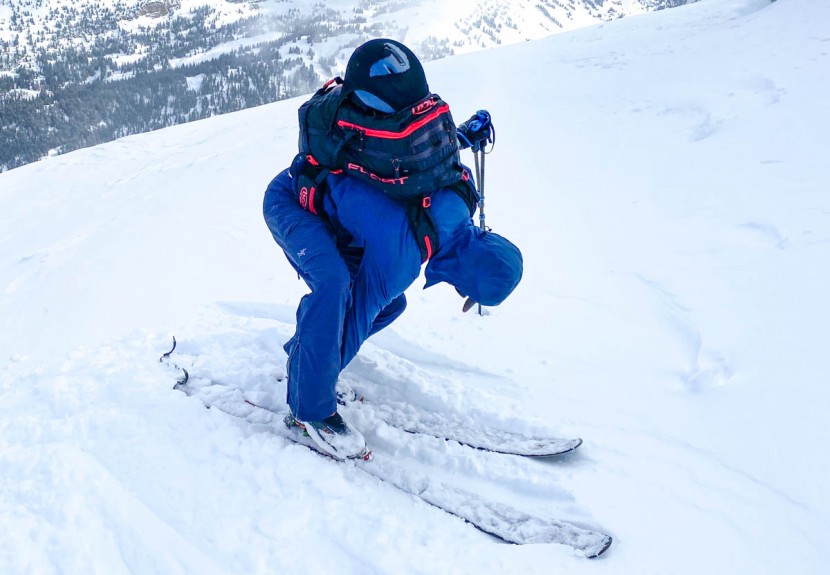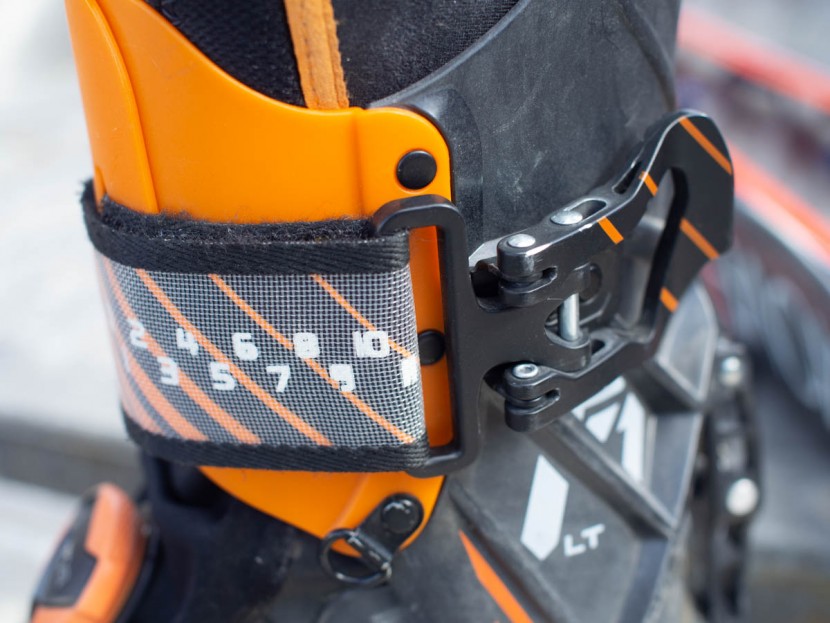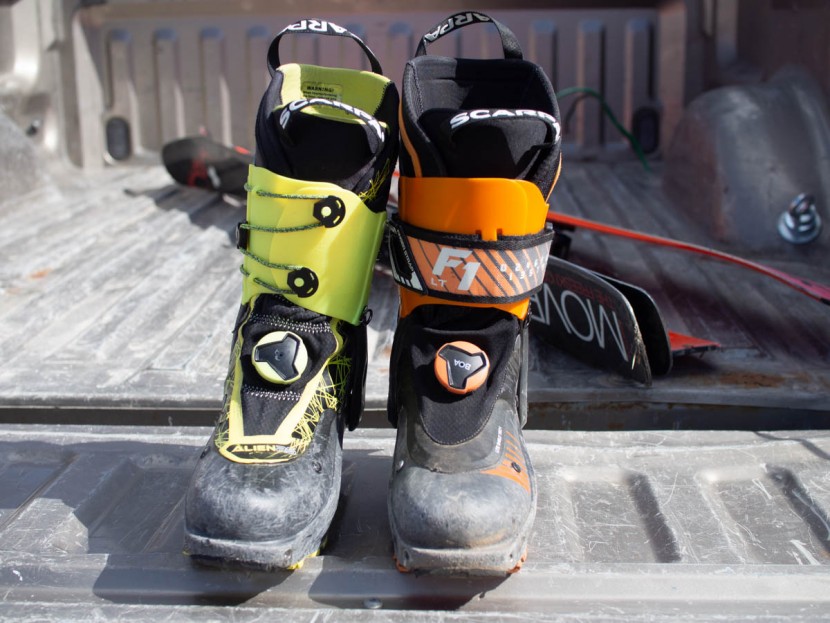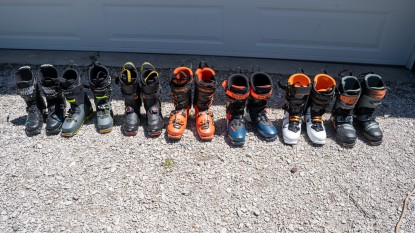Scarpa F1 LT Review

Our Verdict
Our Analysis and Test Results
The Scarpa F1 LT is an iterative improvement in this Italian company's journey to perfect the lightweight ski touring shoe. This is simultaneously an ultralight all-around ski touring boot and a beefed-up skimo race boot. If we had to pin it with one label, we'd lean more in the all-around direction. We have some nitpicks with it, but overall we love it. This is a boot that you can and should use for day-to-day, high-energy (up hill and down) backcountry skiing and ski mountaineering. It'll drive any ski you actually want to lug around in the mountains, and it will hold up for multiple seasons of high-volume action. Its fit is forgiving and wide-ranging. With an Intuition brand liner included, and a reasonable price point, this is a fairly good value.
Downhill Performance
In assessing the downhill performance of touring boots, fit is paramount. Basically, fit is paramount, in every way. After fit, though, there are two main attributes that affect downhill performance. First, stiffness. In terms of stiffness, you want maximum stiffness to the rear and laterally. Next, forward flex. You want your ski touring boots, in downhill mode, to flex forward with evenly increasing support. This is referred to as “progressive” flex.
The F1 LT is stiff enough, laterally and rearward, for intermediate to expert backcountry skiers to ski any gear in any terrain and conditions, with some technique and “energy” adaptations. If you are new to backcountry terrain and snow, this boot will have inadequate and uninspiring support. The forward flex profile of the F1 LT is better than you'd expect. For decades the lightest ski touring boots have always emphasized stiffness over progressive flex. Scarpa has done better than most through the years, but lightweight boots are always going to compromise on the evenness and graduation of the forward flex profile. You get more than you'd expect from this F1; press your shins forward, and you don't hit any hard stops, nor does it fold away from you. The resistance doesn't “ramp up” like we expect from resort boots, but it is better than most lightweight boots.
These are not hard-charging, supportive downhill boots. They are “enough”, but not more than that. They reward centered, attentive downhill skiing and some mileage in adjusting. You will have no problem adjusting to the F1 LT if you are accustomed to lightweight touring boots. These ski better than any other boots we've used in this weight range.
Uphill Performance
The Scarpa F1 LT goes up hill like a dream. The liner and shell work together to provide nearly frictionless action through more range of motion than your ankles are capable of. The liner is thin, with a softened “flex zone” behind your Achilles tendon. We don't recommend it, but we can say that you can easily drive a sensitive stick shift automobile in these boots.
Rock climbing, ice climbing, extended dry-ground walking; none of these are a problem in the F1 LT. Fast, long-stride skinning is a breeze. The low heel lifts of lightweight bindings, even on steep skin tracks, are not an issue with such great ankle articulation. If you are coming from resort boots or beefy touring boots, you won't first believe just how much freedom of motion you get from these and how much it matters over a long day. None of our other award winners have such easy touring performance.
Weight
A pair of the F1 LT weighs 4 pounds 7 ounces. That's 1023 grams per boot. Of that, 809 grams are shell, and 214 grams are liner. 214 grams in a liner is pretty darn light. In many boots, you can save weight and upgrade performance with an aftermarket Intuition brand liner. The F1 LT's liner is made by Intuition and is lighter than basically anything else available. No need to upgrade until the liner wears out.
Comfort and Fit
The Scarpa F1 LT, as compared to a wide sampling of the touring boots on the market, is just over on the wide side of average last volume. The lower boot shell is exactly the same as, the lower boot shell of the revered Scarpa Alien RS, but the “boot board” insert is rumored to be less voluminous. The F1 gives you more room than the Alien RS. This F1 seems to fit more like Scarpa's Maestrale boots than the Alien series.
Our average-footed testers really liked the “out of the box” fit of the F1 LT. Wide-footed testers could make it work with no shell adaptations. Those with low volume feet were able to make things work with thicker insoles or a shim between liner and shell sole. A high-performance fit for those with low volume feet is difficult in this boot.
Warmth
We liked the room in the shell for toes to get blood. We didn't like, as much, the thin materials in both liner and shell. If they fit properly, you'll make these work while moving in any conditions. If you downsize, or make extended stops, or use them on overnight trips, your feet will get cold in the F1 LT.
Warmth is a function of fit and materials. Fit is paramount. The most insulating boots, sized down, will make your feet dangerously cold. The flimsiest boots, allowing your toes room to wiggle, will be warmer than you might expect. The F1 LT isn't the flimsiest boot available, but it is close. Thin liner plus thin shell make for relatively minimal insulation. Keep warm with high-tempo ascent, energetic descents, minimal stops, and booties/overboots for expeditions and camping.
Ease of Use
We really liked the efficiency of the now-discontinued Scarpa Alien RS. Scarpa replaced the Alien RS with the F1 LT. The lower shell is the same on both, and the overall weight is similar. The F1 LT skis at least a little better and fits a little wider. The biggest step backwards, though, is in ease and efficiency. To go from easy uphill mode to downhill mode with the Alien RS was accomplished with one rear-mounted lever. To execute the same transition with the F1 requires four steps. You tighten velcro power strap, tighten velcro main strap, snap the cuff lever and engage the rear-mounted ski/walk lever.
You can cut out a step and save weight with the F1 LT by ditching (sans tools… this could be done on and off in the field and mid expedition, if desired) the power strap. We liked skiing the F1 with no power strap.
You can save another step by leaving the velcro main strap at one tension level. However, this compromises touring efficiency. The cuff velcro strap is tightened by a short-throw cam lever. The difference between tight and loose is just a couple inches. If tightened for downhill performance, flipping the lever open doesn't give you enough slack in the strap to take advantage of the great, free-ranging cuff mobility on the uphill. We found ourselves making the full, three-step transition for any climb longer than a few minutes; the efficiency gains are worth it. It sure seems, though, that Scarpa could make the F1 LT have the same all-in-one transition lever of the Alien RS. Why did they go this route on this boot?
Should You Buy the Scarpa F1 LT?
The award-winning F1 LT isn't perfect, but nearly so. All touring boots strike a balance between uphill and downhill performance. Heck, all ski touring gear strikes this same balance, on some level. But with the F1 LT, Scarpa recalibrates the matrix against which we measure all boots. Further increasing the value of the F1 is the high-quality liner. Boots from other manufacturers are greatly enhanced with liner replacement, sometimes before any use. This strategy automatically adds hundreds of dollars to the initial purchase price. We wish that the F1 was more efficient in transitions, but that is a small price to pay for an otherwise awesome boot.
What Other Backcountry Ski Boots Should You Consider?
The Scarpa F1 LT is a hot rod of a touring boot, though the recently introduced Scarpa F1 XT skis better. The Tecnica Zero G Tour Pro, strikes a similar “curve-breaking” performance balance, with the emphasis tilting toward the downhill portion of your days. The Scarpa Maestrale RS is heavier and skis better than the F1 LT, though it is slightly ligther and skis just as well as the Zero G Tour.
| Awards | |
|---|---|
| Price | $899 List Check Price at Backcountry |
Overall Score  |
|
| Star Rating | |
| Bottom Line | Balanced, all-around ski touring boots that lean in the light-and-fast direction; these are optimized, probably, for what you like about the mountains |
| Pros | Light, free-pivot cuff, appropriate stiffness and flex |
| Cons | Cold, finicky transitions |
| Rating Categories | Scarpa F1 LT |
| Downhill Performance (35%) | |
| Uphill Performance (20%) | |
| Weight (20%) | |
| Comfort and Fit (10%) | |
| Warmth (10%) | |
| Ease of Use (5%) | |
| Specifications | Scarpa F1 LT |
| Weight per Pair (Size 26.5) | 4 lbs 7 oz |
| Binding Compatibility? | Tech only |
| Measured Range of Motion (degrees) | 72° |
| Manufacturer Stated Last Width | 102 mm |
| Weight of One Complete Boot, No Insole | 1023 g |
| Weight of One Boot Shell | 809 g |
| Weight of One Stock Liner, No Footbed | 214 g |
| Stated Flex Index | 95 |
| Liner Design | Tongue |
| Shell Material | Grilamid, Carbon core |











